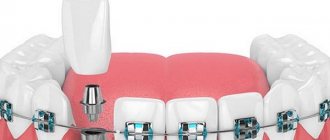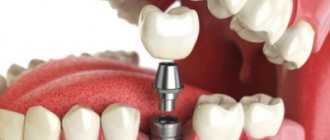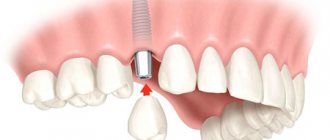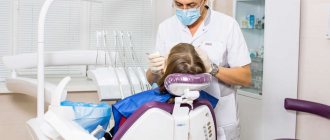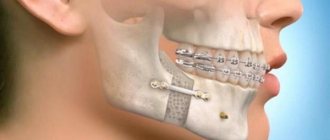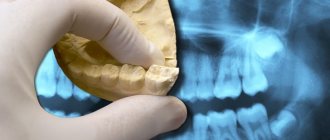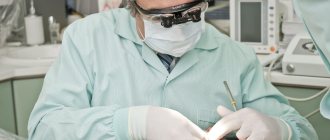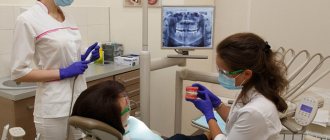Orthodontics as a field of dental science is developing rapidly. Every year new, more modern and improved methods for correcting various defects of the dental system appear. But, despite the rapid progress, some people still believe that an orthodontist only deals with installing metal braces. In fact, his scope of activity is not limited to this, and his competence includes solving many other dental problems.
What does an orthodontist treat in children?
The list of orthodontic diseases, pathologies and anomalies is extensive. These are not only bite defects, but also many other deviations - congenital, hereditary, acquired. The most common problems people come to dentistry for are:
- teeth;
- dentofacial rows;
- bite
Pathologies and dental anomalies
When assessing individual units of a child’s jaws, a pediatric dentist or orthodontist will pay attention to the developmental features of each individual tooth:
- shape - classic or spiky, screwdriver-shaped, barrel-shaped, with deformations of the cutting edge line;
- dimensions - reduced or increased compared to neighboring units;
- tissue structure - normal teeth, underdeveloped condition, excess tissue volume;
- timing of appearance - according to the age of the child, early eruption or late;
- position in the jaw row - rotated, tooth growth from the side of the lip or from the side of the palate, excessive protrusion from the gums, growth in place of another tooth.
Also, the pediatric orthodontist will note the number of teeth in a row - edentulism or the presence of supernumerary teeth.
Almost all of the problems listed are solvable. Modern dental methods can quickly and painlessly change the positions of teeth, reverse pathologically located units, help quickly remove excess teeth and perform prosthetics in the absence.
Anomalies of the dentition
What does the pediatric orthodontist treat in this case? Problems of the dentition are more serious for dental health than single anomalies of growing units. Incorrect position of the jaws affects the quality of speech, creates difficulties in nutrition, and worsens the aesthetics of the face.
The most common problems relate to:
- The size of the jaw rows is excessive growth of one of the jaws compared to the second or a delay in development in both rows.
- The position of the jaw relative to the base of the skull is asymmetry, forward or backward displacement.
- Consistency and symmetry of the arrangement of teeth - poor contact when closing, crowding, rare position, large gaps between units.
Anomalies of bite, occlusion
Pathological bite is the most common problem among young patients. The orthodontist will successfully correct the bite
- distal - the upper dental row is highly developed and protrudes forward;
- mesial - excessive development of the lower jaw is observed;
- cross - when the teeth are closed, the upper dental row intersects with the lower one;
- deep - the upper incisors completely cover the lower ones;
- open - the teeth are only partially connected.
There are many pathologies, and the doctor’s task is to make the correct diagnosis and select the correct treatment.
Causes
They can be divided into several groups.
The first reason is deformation of the dentition. Well, that is. the same crowded teeth. And crooked teeth, by definition, cannot fit together correctly.
The second reason - it is the most important (leading) in the formation of such a bite - is problems with the jaws. It's no secret that teeth grow from jaws. And any problem with the jaws (wrong size or incorrect position) will immediately result in improper closure of the upper and lower teeth.
For example, the jaws are underdeveloped. Immediately there is a shortage of space for teeth with the formation of either crowding of teeth or their protrusion (tilting forward). Well, we have already said that uneven teeth cannot fit together correctly. Or the teeth, for example, are straight, but the lower jaw is located posterior to the upper jaw (the so-called distal occlusion). And the teeth (even even ones) will not be able to close into the correct “lock”.
I repeat once again - the jaws (or rather the problem with them) are the main reason.
During a direct examination by a specialist, you will be able to find out your exact diagnosis, as well as receive a referral for diagnosis or a treatment plan.
There are several main types:
- distal bite
- mesial bite
- open bite
- deep bite
- crossbite
All these types of pathological closure can be combined in various ways and “successfully” complement each other. Therefore, figuring out what is primary (what is the cause) and what is secondary (what is the effect) is not easy.
But Orto-Artel specialists have extensive experience in diagnosing and treating all (any) types of malocclusions. And if you suspect him in your home, you are welcome to Orto-Artel. We will help you solve the problem of correcting this type of bite in adults or children. And we will do it at the highest professional level and at an adequate cost.
The sooner the patient seeks advice from a specialist, the faster and easier it is to get rid of the deficiency. The Orto-Artel clinic carries out all types of diagnostic measures and offers treatment for all types of malocclusions. The most effective way to solve the problem is to install a bracket system, which includes three stages:
- Preparatory. The condition of the oral cavity and jaws is examined, the problem is diagnosed and the correct treatment regimen is selected. After sanitation of the oral cavity, impressions are made and a brace system is manufactured.
- Installation. Lignival structures are attached to the inner side of the dentition, vestibular braces are placed on the outer side. Installing the system is absolutely painless.
- Retentional. At the end of the period of wearing braces, the patient is fitted with retainers, whose task is to secure the position of the teeth. Special structures are attached to the back of the dentition.
Diagnosis of orthodontic diseases
It is important for a pediatric orthodontist to see a comprehensive picture - not only the current state of the oral cavity, but also the rudiments of future teeth and the structure of bone tissue. To do this, the dentist chooses several diagnostic methods:
- Orthopantomography (OPTG) is an x-ray of the bones of the facial skeleton when all the teeth are aligned in one line.
- Teleroentgenogram (TRG) is an x-ray of the jaw in the frontal and lateral projections of the skull.
- Casts are real-size simulations of the jaw to evaluate the position, shape and size of individual teeth.
- Photographing of the face and oral cavity to assess asymmetry, external deformations, and carry out calculations.
- Computed tomography (CT) is a three-dimensional image of the jaw in digital format.
- Video recording - recording abnormal manifestations of jaw function in dynamics.
Also, a pediatric orthodontist may refer the patient for a consultation with dentists or doctors of other specializations to obtain an additional professional opinion.
Preparing for surgery
After a comprehensive examination of the whole body for the presence of contraindications, the oral cavity, and the structure of the skull bones, the doctor begins the preparatory period for the operation:
- Using casts of the jaw, a model is made using high-tech equipment, which will be a sketch of the postoperative jaw apparatus.
- The orthodontist prepares the teeth for surgery by installing braces to pre-align them. This stage is the longest and takes from six months to 1.5 years (possibly longer in the presence of a serious anomaly). While wearing braces, it is important to follow the recommendations of doctors and visit regularly to adjust the braces and evaluate the current result of treatment.
The clinic has the latest equipment, which allows us to conduct any examination of teeth and jaw bones, thanks to which the diagnostic accuracy is at the highest level. And, as you know, a correct diagnosis is half the success of treatment.
Pediatric dentistry: how an orthodontist treats
A pediatric orthodontist chooses a treatment method only after a complete examination of the patient. When making a decision, the doctor takes into account:
- child's age;
- type of bite - milk, permanent, replaceable;
- orthodontic pathology - anomalies of teeth, dentition, bite.
The most popular correction methods:
- myogymnastics (myotherapy) - a course of special exercises aimed at strengthening the muscles of the maxillofacial area;
- surgical method - necessary to eliminate pronounced deformations of the bite, jaw rows, dental sequences;
- hardware therapy - the use of fixed and removable structures to correct the bite or individual units.
Before and after results
Results before and after surgery will vary significantly. Depending on the scope of the surgical intervention, the type of pathology or injury, it depends on when the first results of the operation can be seen.
If the surgical intervention was extensive, screws, screws, pins were installed, then the result can be seen in a couple of months. The patient undergoes CT and TRG to assess changes in jaw position.
If screw fastenings were used during the operation, they are removed after 3-4 months, after which the result of the surgical treatment is finally assessed.
The final result of the operation depends both on the professionalism of the surgeon and on the patient’s compliance with all the doctor’s recommendations. The correct behavior of the patient during the rehabilitation period affects the final result of the surgical intervention.
Orthodontic devices for bite treatment
Orthodontic systems are created or customized to address a patient's specific problems. When installed on the teeth, the corrective system begins to put pressure on abnormally located areas, forcing:
- teeth move into the correct position;
- dental rows expand to anatomically correct sizes;
- muscles tighten, returning them activity and strength.
When choosing a device for treatment, an experienced orthodontist will take into account the absence of certain restrictions. Correction of anomalies is possible in the following cases:
- the teeth experience sufficient pressure to move into the desired position;
- the orthodontic apparatus is well fixed and supported;
- the dentofacial row is prepared - there is a place where the tooth that can be moved or rotated will fit;
- the tooth being moved has no obstacles to movement.
The main structures for correcting malocclusion used by an orthodontist:
- plates are mainly removable systems that help move teeth and expand the jaw to the desired size;
- trainers - silicone products for high-quality fixation of the position of the tongue and teeth, helping the teeth of the permanent bite to grow correctly and solving a number of other orthodontic problems;
- aligners are individually created aligners that are invisible on the teeth and can quickly move incorrectly positioned teeth to anatomically correct points;
- braces are non-removable orthodontic systems for high-quality correction of any malocclusion.
Rodikova Tatyana
Today, braces and aligners are competitors. Many parents ask for aligners for their children, since they are practically invisible on the teeth. Unfortunately, aligners do not cope with all malocclusions, but if possible, then, of course, I will agree with the patient’s wishes.
Health problems due to malocclusion
Not many people realize that an orthodontist is also a person who, through treatment, can affect the overall health. The fact is that when the bite is disturbed, a number of very unpleasant and sometimes even dangerous processes begin to occur in the body:
- due to the incorrect location of some teeth, the rest may suffer, because they bear a heavy load, leading to wear and abrasion of the enamel, increased sensitivity, premature destruction,
- with malocclusion, facial asymmetry occurs, the functioning of the temporomandibular joint is disrupted, resulting in headaches, migraines,
- “wrong” teeth can injure the cheeks, lips, tongue, and other mucous membranes. Inflammatory processes cannot be excluded here,
- deterioration in breathing, swallowing and apnea, various speech defects,
- discomfort when chewing food and limited chewing function lead to diseases of the gastrointestinal tract, indigestion, and ulcers.
Incorrect positioning of teeth
Now do you understand how important it is to consult a specialist in a timely manner? An orthodontist is the one who will correct the bite and thereby help get rid of the consequences of a malocclusion - that’s for sure.
Even if you do not experience significant problems with your bite, be sure to visit a doctor. If you have hidden malocclusions, the orthodontist can easily determine this during the first visual examination and prescribe corrective treatment.
Indications for contacting an orthodontist
A visit to the orthodontist should be scheduled after the primary baby teeth appear—at 3-4 years of age. An early examination will help to identify pathology at the stage of formation of the dental system of a young patient, which will significantly facilitate and speed up treatment.
You should also schedule a mandatory visit to the orthodontist if you have:
- bad habits in a child - he will not part with the pacifier, constantly holds his thumb in his mouth, chews pencils and pens;
- mouth breathing - reluctance to breathe through the nose indicates orthodontic pathologies;
- obvious deviations in the development of the dentofacial apparatus - congenital or appearing as teeth grow or change;
- difficulties in swallowing, chewing;
- speech therapy problems, difficulties in pronouncing individual sounds;
- large interdental spaces;
- crowding.
What is overbite
The bite is the relative position of the lower and upper rows of teeth when they are closed. A less common name is occlusion.
If it is correct, the upper teeth slightly cover the lower teeth (less than a third). This allows the chewing load to be distributed evenly and looks aesthetically pleasing.
The bite takes more than one year to form. The process includes 5 time periods:
- 0–6 months (the upper jaw is larger than the lower jaw, which is corrected through the baby’s active efforts during feeding);
- 6 months - 3 years (baby teeth erupt, temporary bite is formed);
- 3 years - 6 years (active jaw growth occurs, the body prepares for the appearance of permanent teeth);
- 6–12 years (jaws continue to grow, permanent teeth erupt);
- 12–16 years (the final bite is formed).
Deviations from the norm at least at one of the stages can lead to anomalies of the dental system.
So, if when talking, eating, or in a free state, closure defects are observed, they speak of a malocclusion.
How to prepare your child for an orthodontic appointment
The initial appointment with an orthodontist takes place without any preparation. The child just needs to brush his teeth and eat beforehand. The latter is desirable, as it will help reduce salivation and facilitate the examination procedure. The child should also be told about the doctor’s specialization. In simple words, explain who this pediatric orthodontist is and what he treats.
An orthodontic examination is a painless procedure. It does not cause fear or discomfort in the baby, but it helps to identify deviations in the development of the dentition as early as possible.
Soldatenkova Alina
For fearful children, our clinic provides adaptation techniques. Such meetings help to get acquainted with the dental center and learn in a playful way about the work of dentists. The initial appointment can be combined with adaptation and an examination of the teeth and mouth can be carried out unnoticed by the child.

